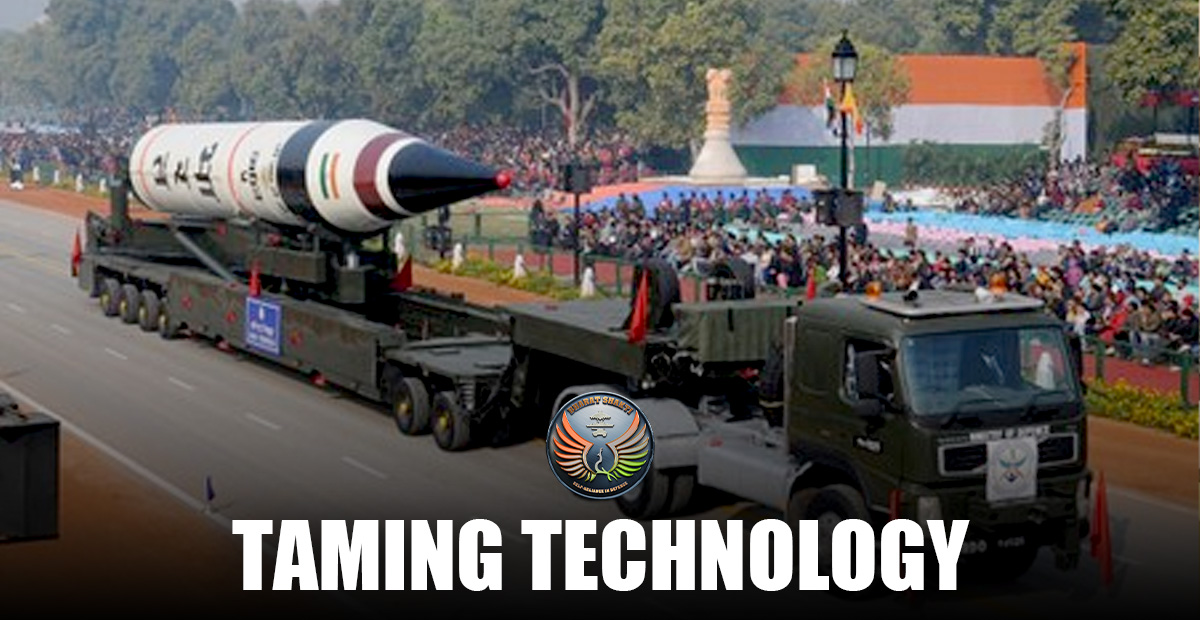Editor’s Note
India has joined the global chase to attain a leadership position in technology development and has reached a level of eminence in certain areas. The UIDAI is an example of such success. We are now in the race in areas like Quantum, Semiconductor and AI. The hugely successful Indian Integrated Guided Missiles Development Program (IGMDP) of 1983 has witnessed unparalleled success. It provides a framework that can be utilised to hasten our pace in our selected areas of pursuit.
The New Tech World Order is defined by 4DQ—Data, Digitisation, Digitalisation, Disruption, Quantum. While these Ds have fueled digital transformation globally, giving rise to a large number of dual-use technologies that are drivers of automation and autonomous applications, disruption is not only transforming technologies at an unprecedented pace but also transforming business concepts, models, processes, and practices.
Technology is on the gallop. The human-to-human communication over a period upgraded to human-machine interface (HMI) which is on the anvil to another major disruption in the foreseeable future, transcending Machine to Machine (M2M) with zettabytes (10 of data transfer in a fraction of a second. It calls for a major focus on chip-based embedded systems with software on chips and platforms, quantum computing and processing for data management and 6G for high-speed data transfer, and the race for the swift continues.
India has embarked on a major technology development journey, with Mission Quantum, Mission Semiconductor, and Mission AI having succeeded in digital transformation through the digital public infrastructure (DPI). The Indian DPI is unique—the UIDAI Aadhar card as an enabler beyond identity, a unified payment interface beyond digital currency, and a connection from the busiest urban hub to the remotest village on the edge. However, perhaps the flagship National Tech Program is the Indian Integrated Guided Missiles Development Program (IGMDP).
The IGMDP
The astounding success of ISRO in satellite launch vehicles, bereft of any dependence on imports of key technologies, is a forward-thinking Nation’s approach to IGMDP in order to become self-reliant in Missile Technologies. The Indian Integrated Guided Missiles Development Program (IGMDP) -1983 is the first mega DRDO flagship project to design and develop five guided Missiles: Agni as technology demonstrator, Prithvi as SSM, Akash and Trishul is SAMs and ATGM Nag, are case study on technology sovereignty.
Close on the heels of this strategic decision and a consequent rollout, the Missile Technology Control Regime was slapped in April 1987 in an endeavour to contain the proliferation of missiles and missile technology. Under such endeavours in technology denial by the G7 haves then, India displayed a strong political will and put together a multi-pronged approach – developing indigenous research, developing Indian PSUs, developing Indian industry, premier technical institutions including IIT and a technology development consortium with key tech departments under the government.
The key lessons derived were that the payoffs were beyond missile technology and defence – materials for airframes, guidance control system hardware and software algorithms, accelerometer and gyros, inertial measuring units, onboard computers, propellants and liquid propulsion engines, precision technologies in hydraulics and pneumatic actuators, pryros and radio fuzes, to name a few, had applications in large number of dual-use civil applications. The biggest impact was that India ignited minds with the confidence, conviction, and commitment of YES, WE CAN. Brahmos with Russia, MRSAM with Israel, IGMDP continues to churn out variants of missile systems for terrestrial, surface-to-air, air-to-surface, and underwater-to-surface targets, etc. IGMDP teaming with ISRO and private space agencies continues to maintain the lead globally in the Missile – Space Technology Zone of Interest and Influence, primarily due to a progressive whole of Nation Program Approach.
The IGMDP Based Program Approach
The Program approach is a best practice in developing long-term technology projects. The IGMDP had two primary verticals – project vertical and Systems or Technology Vertical. The Projects comprised Agni, Prithvi, Akash, Trishul, Nag, Air launched Prithvi, Ship Launched Prithvi and many more variants in the continuum of time, which were the deliverables to the Armed Forces and now an export-oriented enterprise. The vertical systems comprised the airframe, warhead, guidance, control, liquid and solid propulsion groups to create materials and design and develop deployable systems for each missile based on the function, form and fit.
The program has stood the test of time and gone into a consortium approach with Russia and Israel, which is on a progressive trajectory in step with technology upgrades. The Systems Group partnered with Academia and industry for all Technology Readiness Levels TRL 1 to 7 needs, while the Project Groups engaged with the industry to deploy scale-up TRLs 8 and 9. It brought focused engagement and meaningful integration to create a win-win Public Private Program Partnership. Each Project and Systems Group had mission-oriented time-bound milestones to exercise strict control of technology and product progression. That said, India needs an Integrated Program to create a formidable technology landscape, be it Big Data & AI, quantum, semiconductors, unmanned autonomous systems and others.
Quantum Technologies-The Program Approach
The Atmanirbhar Bharat playbook must strive to bridge this gap through a two-pronged womb-to-tomb approach in quantum tech, the next disruptive technology, with a product-based technology approach from a womb perspective and a life cycle management approach from a tomb perspective. It requires that the National Mission emulate a long-term view through a program model. For example, the National Quantum Mission could be served best through a long-term Indian Integrated Quantum Mission Program comprising two structures, akin to IGMDP – the Project Vertical (Product Based) and the Technology Vertical (Systems Based). The Project Vertical may cover Project Quantum Communications, Project Quantum Computers, Project Quantum Cyber, Project Quantum Radars, etc., and the Technology Vertical may cover Quantum Computing & Qubit Systems, Quantum materials and molecules, Quantum sensing systems, etc. Such a formal, organised approach to convert a National Mission into a deliverable program is a compulsion and no longer a choice.
Conclusion
Atmanirbhar Bharat and ‘Make in India’ (MII) is about producing indigenous tech-based equipment, MII deployment to fight Indian wars with Indian equipment, exports and life cycle sustenance support management. Accordingly, OEMs must look beyond the production RoIs and cull out a SMART (specific, measurable, achievable, realistic and timely) life cycle support addon package, given the short tech obsolescence cycles. To that extent, technology forecasting, technology planning, technology development, certified training in basic systems skills and equipment-specific product skills is an opportunity for academia and industry partnerships, which requires India to create a mission-oriented strategic focus and a pencil beam program-oriented tactical execution.
The National development triangle of geopolitics, geostrategy and geoeconomics has undergone a geometrical shift, with geotechnology making it a square. Technology today is an undisputed game-changer. Turkey, the new tech entrant, came into prominence when they launched their Bayraktar Drone Program driven by Selcuk Bayraktar, their MIT Grad, to create a wide range of UAVs & UCAVs. India needs a formidable Unmanned Autonomous Systems Program for strategic defence and commercial applications. IGMDP replication in all deep and high-tech future programs is the need of the hour. We have the power of youth bulge, intrinsic research, design and development capability, support of the Indian diaspora abroad and a foreign collaboration playbook as an opportunity. Let us strategize and adopt a Program approach for SMART technology supremacy—opportunities beckon.
Lt Gen (Dr) Anil Kapoor (Retd)






















